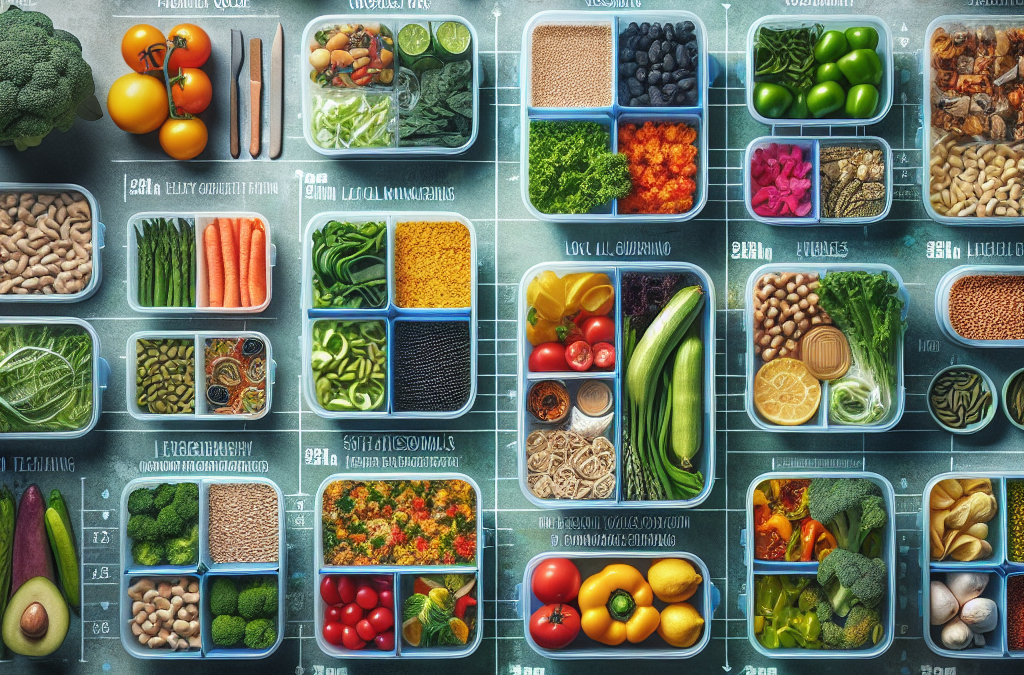Embrace Seasonal Eating
Why Seasonal Foods Matter
When I first learned about seasonal eating, I was taken aback by how much it can change your meal planning game. Eating with the seasons not only ensures you’re getting the freshest produce but also supports local farmers. Plus, seasonal fruits and veggies tend to be at their peak in flavor and nutrition. There’s nothing quite like biting into a juicy, sun-ripened tomato in the summer.
This practice also makes your grocery shopping way easier. You can walk into the market and already know what’s in season, cutting down the time spent browsing. For instance, in the fall, you can look forward to pumpkins, squash, and hearty greens, which allow for a variety of delicious dishes. I like to peruse local farmer’s markets to see what’s abundant.
On a practical level, seasonal eating can save you money. Seasonal produce is often cheaper since it doesn’t need to be imported from far away. So not only are you improving your eating habits, but you’re also doing wonders for your wallet!
Planning Around the Seasons
Once I understood the importance of eating with the seasons, the next step was figuring out how to plan meals accordingly. I recommend checking out seasonal produce charts. They’re super handy! For example, if it’s spring, I might plan meals with asparagus and strawberries. Not only do they match the season, but they also offer such vibrant colors and flavors to my plates.
Creating a seasonal meal calendar has really worked wonders for me. I sit down every month and jot down which fruits and veggies are in season, then I brainstorm recipes that highlight those ingredients. This not only keeps my meals exciting but helps me to waste less food, as I’m fully utilizing what I buy.
Also, if you’re into preserving, consider canning or freezing seasonal items for later use. I love to make jams with berries in the summer and pull them out during the colder months. It keeps that summer taste alive and saves me a bit of cash—score!
Restaurant Choices That Support Seasonal Eating
Dining out doesn’t have to derail your sustainable meal planning. I always look for restaurants that emphasize seasonal menus. These places often showcase local produce, and it’s a great way to try new dishes inspired by the season. It adds a fun twist to my usual meal choices!
When I eat at these establishments, I often ask the staff about their sources. Many local farms partner with restaurants to provide fresh ingredients. Knowing where my food comes from makes the dining experience that much more satisfying.
Lastly, don’t hesitate to try your hand at making your favorite restaurant dishes at home with the seasonal twist! This has been a game-changer for me. I get to experiment with flavors and create delicious meals while still sticking to my sustainable meal planning goals!
Reduce Food Waste
Understanding Food Waste
Did you know that about one-third of the food produced globally is wasted? When I realized this, I knew I had to do something about it. Reducing food waste isn’t just good for the planet; it can also help you save some major green. I started by assessing what I was throwing away regularly. This was a total eye-opener for me!
One thing I did was to arrange my fridge properly. I learned to store fruits and vegetables in the right spots to prevent them from going bad. For example, putting apples in the crisper drawer at the bottom keeps them fresher longer. I also keep a rotating list of what I’ve got in there on my fridge so nothing gets lost and forgotten.
I even take it a step further by incorporating food scraps into my cooking. Things like vegetable peels or herb stems can be transformed into broths. It’s incredible how much more you can get from your food when you get a little creative!
Creative Meal Prep
Meal prep has been one of my best allies in the fight against food waste. I dedicate a little time each week to plan my meals based on what I have on hand. This helps ensure that nothing goes to waste. For instance, if I have some wilting spinach, I might whip up a frittata or toss it into a smoothie.
Another tip? Utilize your pantry! Sometimes we overlook dried beans and grains. Making a pot of beans can be a delicious base for several meals throughout the week. I like to cook them once and use them in tacos, salads, or even savory bowls.
Not only does meal prep help reduce waste, but it also makes weeknight dinners stress-free. I find that when I have everything ready to go, I’m less tempted to reach for that takeout menu.
Smart Shopping Habits
When I changed my shopping habits, it transformed my entire approach to reducing waste. I now take a list, and I stick to it—I don’t want to buy things just to watch them go bad later. I also try to buy items in bulk when possible, especially grains, beans, and spices. This not only reduces packaging waste but also often saves money.
While shopping, I’ll usually opt for imperfect produce. You’d be surprised at how good those so-called “uglies” taste. Not to mention, they’re usually way cheaper! I’ve found that grabbing these items not only reduces waste but gives me opportunities to experiment with new recipes.
Finally, I’ve started using apps that help track expiration dates and suggest recipes based on what I have. This makes it a breeze to stay on top of things and helps me stay creative in the kitchen!
Incorporate Plant-Based Meals
Health Benefits of Plant-Based Eating
When I swapped out a few animal products for plant-based options, I was amazed at how great I felt. Incorporating more plant-based meals into my diet not only improved my overall health but also helped me be more conscious about sourcing my food sustainably. Beans, lentils, and all sorts of grains are nutrient-dense and quite affordable!
Plus, plant-based eating ties back into seasonal eating beautifully. Many delicious legumes and vegetables shine during certain times of the year. This adds a fun challenge to my meal planning, trying to whip up creative and tasty dishes that prioritize plant-based goodness.
However, it’s not about going completely vegan; even making small changes can massively impact your health and the environment. I love to try Meatless Monday as a start. It’s a way to ease into the concept while also having fun exploring exciting new recipes.
Get an Amazing Discount on the Best Certified Organic Whole Food Supplement!
Recipes to Try
Creating a repertoire of plant-based recipes has been so rewarding! I’ve got everything from hearty chili packed with beans to vibrant salads loaded with fresh produce. What’s great is that many traditional recipes can easily be adapted. For instance, swapping regular pasta for chickpea pasta has been a total game-changer for me!
One of my favorite meals is a roasted vegetable and quinoa bowl topped with tahini. It’s simple, delicious, and uses up any leftover vegetables in my fridge. Plus, experimenting with spices keeps the flavors interesting.
Also, don’t underestimate the power of apps and online communities. There are so many resources and recipe ideas out there to inspire you. I often find myself scrolling through Instagram for fresh meal ideas, which ignites my creativity in the kitchen.
Benefits to the Planet
Choosing plant-based meals isn’t just about health; it’s about doing right by our planet too. Livestock farming is a significant contributor to greenhouse gas emissions, and reducing our meat consumption can have a real impact. When I learned about this, it gave me an extra motivation to keep up with my plant-based journey.
Additionally, plant-based diets generally require less land and water to produce. Supporting more sustainable food systems is something I’m passionate about, and by opting for plants, I feel like I’m doing my part.
It’s a win-win situation because I get to enjoy delicious food while being kinder to our planet. Plus, I get to share this knowledge with friends and family, spreading the mission of sustainability further!
Practice Mindful Eating
What Is Mindful Eating?
Mindful eating is something I’ve really come to appreciate on my sustainable meal planning journey. It’s about savoring each bite, paying attention to flavors, aromas, and how the food makes me feel. It’s a simple concept but can have a profound impact. By being present during meals, I’ve found myself not only enjoying my food more but also recognizing when I’m satisfied.
Practicing mindful eating also helps with portion control, which is crucial for reducing food waste. I’ve learned to listen to my body’s hunger cues, making me less likely to overindulge. It’s all about finding that balance and truly appreciating every meal.
Creating a pleasant dining atmosphere has helped immensely. I try to sit at the table without distractions like my phone and TV. This small change allows me to really engage with my food, my thoughts, and the people I share meals with. It’s been such a rewarding practice!
Connecting with Your Food
Something that has truly enhanced my mindful eating practice is connecting with the source of my food. Visiting local farms or getting to know your farmer through markets helps foster that connection. There’s something incredibly satisfying about seeing where your food comes from and knowing the effort that went into growing it.
Also, consider growing your own herbs or veggies, even if it’s just a small windowsill garden. The satisfaction of using something you’ve nurtured in your meals adds a whole new level to eating mindfully. I love snipping fresh basil or parsley whenever I can. It’s like a culinary treasure at my fingertips!
Further, engaging with communities focused on sustainable practices can help reinforce this connection. Sharing recipes and experiences helps deepen my relationship with food.
Learn and Reflect
Finally, I believe that learning and reflecting on my eating habits is a game-changer. Keeping a food journal can be an eye-opener. Writing down what I eat and how it makes me feel helps me notice patterns over time. I’ve found that certain foods energize me, while others may leave me sluggish. This knowledge influences my future food choices positively.
Slowly, I’ve begun to shift my mindset into considering the impact of my food choices on both my body and the planet. Each meal is an opportunity for me to make choices that align with my values. It’s incredible how mindfulness can transform my meals from mere fuel into joyous experiences!
Overall, incorporating these areas into my sustainable meal planning has been an evolving journey, but each step feels rewarding. I hope you find these strategies as beneficial as I have!
FAQs
1. What is the first step to start with sustainable meal planning?
The first step is to embrace seasonal eating. By focusing on what’s in season, you’ll enjoy fresher, tastier produce while supporting local farmers.
2. How can I reduce food waste in my daily life?
Start by meal prepping and planning your meals around what you already have. This will help you minimize waste and rely less on impulse buying.
3. Do I need to go entirely plant-based to benefit from sustainable meal planning?
No way! You can simply incorporate more plant-based meals into your diet gradually. Even Meatless Mondays can make a difference.
4. How can I practice mindful eating at home?
Create a pleasant dining atmosphere without distractions. Focus on your food, savor each bite, and listen to your body’s hunger cues.
5. What’s a practical action for someone just starting with sustainable meal planning?
Start by making a list of seasonal fruits and vegetables and plan meals around them. This can kickstart your journey to sustainable eating!
Get an Amazing Discount on the Best Certified Organic Whole Food Supplement!
Related Content
- The Ultimate Guide to the 10 Best Whole Food Based Diet Strategies for 2025
- Nutrient-Rich Whole Foods for Energy Boost
- 10 Effective Whole Food Diet Smoothie Tips for 2025 to Boost Health
- The Power of Post-Workout Plant Nutrition
- The Ultimate 2025 Guide to 10 Powerful Raw Fruits and Vegetables That Boost Your Health




